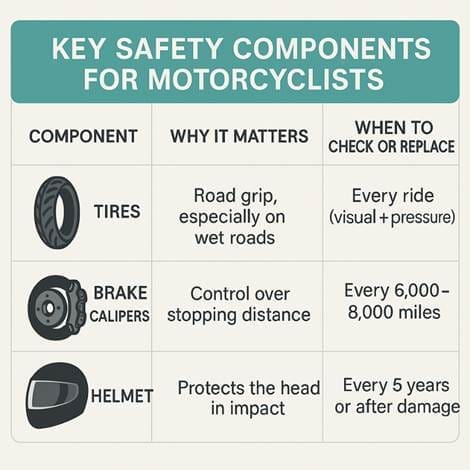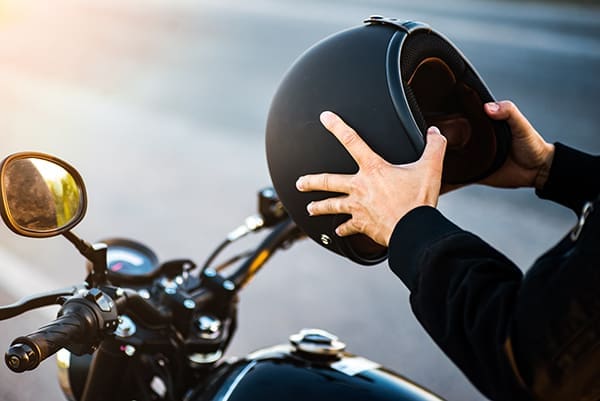We have received payment for the content in this article. Learn more.
Staying safe on two wheels means more than just riding skill. It starts with understanding how key components like tyres, brakes and helmets work together. Even the smallest issue with one of these elements can lead to big problems on the road.

How tyres influence control and stability
Motorcycle tyres are designed to provide reliable contact with the road surface. They are not just rubber rings, they are the foundation of grip and stability. Tread pattern, pressure and wear all affect how your bike behaves, especially when cornering or braking.
Even if a tyre looks good, ageing rubber or uneven wear can reduce performance. Experts recommend replacing tyres every five to six years, even with acceptable tread depth. Old rubber loses elasticity, especially in wet conditions.
Tyre tread depth and grip safety
| Tread Depth (mm) | Grip level | Action needed |
| 4+ | Excellent | No action required |
| 2–3 | Reduced | Monitor regularly |
| <1.6 | Dangerous | Replace immediately |

Why clean brake callipers make a difference
Braking power depends on more than just pads or fluid it also hinges on the condition of the calliper. This component presses the brake pads onto the disc. If the calliper’s pistons are stuck or dirty, braking response slows and stopping distance increases.
Keeping callipers clean and well-lubricated is essential. This includes brushing the pistons gently and applying high-temperature grease to guide pins. Bleeding brake fluid once every 12–24 months is also critical for sharp, reliable stops.

Brake system checklist for riders
- Inspect calliper function every 6000–8000 miles
- Use proper grease on guide pins
- Replace pads under 2mm
- Watch for uneven wear indicating piston issues
Understanding when your helmet stops protecting
While tyres and brakes keep your bike on the road, a helmet helps keep you safe in case of impact. But its protective abilities degrade over time.
“The lifespan of a helmet depends on various factors, such as its usage, maintenance, and the materials used in its construction. Typically, manufacturers advise replacing your motorcycle helmet every five years, even if it seems in good condition.” AUTODOC
Sun exposure, sweat and repeated use break down the EPS foam inside. Even if the shell looks fine, the ability to absorb shock fades with age.

Signs it’s time to replace your helmet
- More than five years old
- Dropped or involved in an accident
- Loose or degraded inner padding
- Fit or comfort noticeably changed
Why small parts protect you in a big way
Real safety starts with the basics. Performance is important but so is confidence in your equipment. Reliable tyres, clean braking components and a well-maintained helmet form a safety triangle that keeps you in control in every situation.
Whether you ride every day or just on weekends, caring for these parts ensures smoother handling, safer braking, and peace of mind on the road.
Simple safety habits to adopt before every ride
✅ Check tyre pressure and tread
✅ Inspect brake pads for wear or squeal
✅ Store your helmet away from direct sunlight
✅ Replace tyres with those suited for your riding style
✅ Don’t ignore odd sounds or pulling during braking.
Final thoughts…
Motorcycle safety is never just about speed or skill, it’s built on everyday habits and attention to detail. Reliable tyres, responsive brakes and a helmet that’s still structurally sound are not extras, they’re essentials.
By checking these components regularly and following expert guidelines, riders not only protect themselves but also enhance their overall riding experience. Smooth handling, shorter stopping distances and effective protection in case of an accident are all outcomes of proper maintenance.
Whether you’re a new rider or an experienced motorcyclist, staying proactive with basic checks is one of the most important decisions you can make. Safety isn’t just found in emergency situations it’s built into every ride before you even leave your garage.


